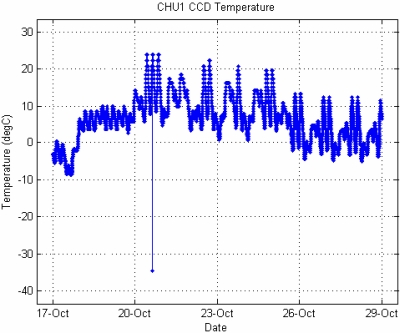No. 45 - Push-broom Operations
One of the improvements recommended for the push-broom operations was the change from High Thermal mode to Low Thermal Mode. The main reason was to lower the working temperatures of the star trackers. The change was implemented on 10 October and gave the FCT a surprise on 17 October when the spacecraft experienced it's first (partial) eclipse since the enforcement of thermal mode. On exit from the eclipse at 11:56 UTC it was noted that the spacecraft was in thermal mode low as expected but also safe heating mode had been triggered. This behaviour was missed in previous analysis and was overcome by another strategy proposed by SSC. This was successfully implemented on 25 October.
Spacecraft Status
AOCS
Due to the nature of push broom operations the -Y face of the spacecraft is exposed to the Sun for extended periods. This has had the effect of increasing the temperatures in one of the startracker units. Push broom operation is defined as a flight direction where the ground-track velocity is along the AMIE CCD axis.
The temperature in CHU2 was relatively high in the first three days of the reporting period with peak temperatures reaching 22.38° C. This is entirely due to the widely reportedly problem of the inner baffle of CHU2 being slightly exposed to sunlight when the +X axis is pointing at the Sun. The subsequent drop in CHU2 temperatures is due to the push broom activities and the switch to low thermal settings.
 |
|
Change in temperature in CHU1 during late October |
Temperatures for CHU1 were low in the first 3 days of the reporting period. The peak temperature, however, increases as the push broom operations begin on 20 October due to the illumination of the -Y face. Since CHU1 is close to the -Y face of the spacecraft with its baffle sticking out into the -Y face, the temperature for the CCD increases considerably to a peak of almost 24° C.
As the thermal low settings are activated on 25 October there is a noticeable drop (around 6° C) in the mean and peak temperatures of CHU1.
The table below summarises the observed startracker temperatures during the reporting period.
| Camera Head Unit |
Min. T (°C) |
Max. T (°C) |
Average (°C) |
| CHU1 |
-11.64 |
23.96 |
1.02 |
| CHU2 |
-6.9 |
22.38 |
6.48 |
Orbital Information
|
SMART-1 OD380 Close to Apolune 1520 Elements WRT Moon and its equator of date | |
| Pericentre Distance (km) | 2347.193891 |
| Apocentre Distance (km) | 4487.781670 |
| Semi Major Axis (km) | 3417.487781 |
| Eccentricity | 0.313181 |
| Inclination (°) | 90.128177 |
| Ascending Node (°) | 238.116916 |
| Argument of Pericentre (°) | 277.708286 |
| True Anomaly (°) | 179.999998 |
| Osculating Orbital Period (h) | 4.979844 |
The changes since apolune 1486 are as follows:
- semi-major axis +0.4 km
- perilune height +19.8 km
- apolune height -19.0 km
- orbital period +0.1 min
